This article is currently posted on ConstructionSpecifier.com.
Panic hardware, also known as an exit device, is designed to provide building occupants fast and easy egress in an emergency. Because of its durability and ease of use, panic hardware is commonly installed in places where it isn’t required by code. But despite its popularity, the question, “When is panic hardware required by code?” is one that many specifiers continue to struggle with because there isn’t a simple answer to this seemingly simple question.
The Life Safety Code (NFPA 101) and the International Building Code (IBC) both include requirements pertaining to panic hardware, but those requirements vary depending on which publication and edition are being enforced in a particular jurisdiction. Complicating matters further, panic hardware is frequently combined with electrified options such as electric latch retraction, delayed egress, and controlled egress that carry with them additional restrictions and requirements. In an effort to help bring some much-needed clarity to this issue, we’ll explore the code requirements that drive the use of this hardware as well as some of the more common exceptions and restrictions you should be aware of when specifying these devices.
Code Requirements
Panic hardware is only required by code for a few occupancy types. In the 2000 and 2003 editions of the International Building Code (IBC), panic hardware was required on egress doors serving Educational and Assembly Occupancies with an occupant load of 100 people or more (as well as certain High Hazard occupancies). Beginning with the 2006 edition, the IBC requires panic hardware on these occupancy types with an occupant load of 50 people or more (and all High Hazard occupancies). Since the occupant load is determined by the area of a room divided by a required number of square feet per person (the factor varies by occupancy type), this means that panic hardware is required for much smaller rooms when referencing the newer editions of the IBC.
Note that the codes also include an exception for the main entrance of certain occupancies, including Assembly occupancies of a limited size, which may sometimes be equipped with key-operated locks instead of panic hardware.
In addition to Assembly, Educational and High Hazard occupancies, the 2014 edition of the National Electrical Code (NFPA 70) requires panic hardware or fire exit hardware on doors within 25 feet of the required working space for rooms housing:
- equipment with more than 600 volts,
- equipment with less than 600 volts but more than 800 amps, with overcurrent devices, switching devices, or control devices, and
- battery rooms
Previous editions of NFPA 70 include slightly different requirements for panic hardware on electrical rooms. Panic hardware or fire exit hardware may also be required for mechanical rooms such as boiler rooms, incinerator rooms, furnace rooms, and refrigeration machinery rooms. The IBC includes requirements for panic hardware on some electrical rooms.
The AHJ may request panic hardware in other instances if he or she believes that a particular hazard exists and panic hardware is required for life safety. If a door is not equipped with a latch or lock (push/pull application), the door is not required to have panic hardware. Keep in mind that when an application requires panic hardware, all of the doors in the means of egress from that room or area will typically require panic hardware, including the exit access, the exit, and the exit discharge. This does not apply to doors which require panic hardware because of the National Electrical Code, as this code only requires panic hardware on doors within 25 feet of the required working space.
Panic hardware is listed in accordance with UL 305 – the standard for panic hardware, and is used on doors that are not fire rated. Fire exit hardware is a type of panic hardware that is tested and listed for use on fire door assemblies, in addition to the UL 305 listing. The dogging feature, which allows the latch to be manually held retracted, is not supplied on fire exit hardware because fire doors must have an active latchbolt to keep the door closed and latched during a fire. As we’ll discuss later in this article, electric latch retraction may be used to electrically dog the latch on fire exit hardware, but the latch must project automatically upon actuation of the fire alarm.
Other Code Considerations
- Where panic hardware is required, the actuating portion of the device (touchpad or crossbar) must be at least half the width of the door leaf.
- Current codes require panic hardware to be mounted between 34 inches and 48 inches above the floor. Existing panic hardware may have been installed at a different mounting height in accordance with previous code requirements.
- Some codes and standards require panic hardware to operate with a maximum of 15 pounds of force, while other codes and standards limit the operable force for hardware to 5 pounds. A special UL listing indicates panic hardware that is certified to operate with 5 pounds of force or less.
- No additional locking device (deadlock, chain, padlock & hasp, etc.) may be installed on a door required to have a panic device, and panic hardware may not be equipped with any device that prevents the release of the latch when the touch-pad or cross-bar is pressed. The exceptions to this are a) electromagnetic locks released by a sensor or by a switch in the panic hardware, b) delayed egress locks which release after 15 seconds to allow egress, and c) controlled egress devices which are allowed in some types of health care units such as memory care and maternity.
- When panic hardware is used on fire doors, it must be fire exit hardware that has been tested per UL 10C – Positive Pressure Fire Tests of Door Assemblies, or another fire test standard, and the door must be equipped with a label stating “Fire Door to be Equipped with Fire Exit Hardware.”
- If panic hardware is used on balanced doors (doors where the pivot point is located several inches in from the hinge edge of the door) a pushpad/touchpad device must be used and the actuating portion of the device must not extend more than half the width of the door. Crossbar style devices may not be used on balanced doors. The reason for this is that if the actuating portion extended all the way over to the hinge edge of the door, a building occupant could push on the wrong end of the panic device and the door would not open.
- In some jurisdictions, doors and hardware must meet testing requirements for hurricane and tornado protection. Consult the applicable codes and manufacturers’ certifications for compliance information.
Selection Criteria
Now that we’ve explored the basic code restrictions regulating the use of panic hardware, let’s look at what styles are available. There are three basic types of panic hardware, dependent on aesthetic requirements, door design, and a few other factors.
- The touchpad style is the most common style used for modern buildings and allows flexibility when electrified options such as electrified lever trim, electric latch retraction, delayed egress, or controlled egress are required.

- The crossbar style is often used when aesthetics dictate a minimal silhouette for glass doors, or a vintage look, but the electrified options are sometimes limited because of the lack of space in the device to house electronic components. The width of a door’s vertical stiles must be considered when specifying or supplying touchpad or crossbar style panic hardware.

- Recessed panic hardware reduces the projection of the hardware from the face of the door, but requires a cut-out in the door and may limit the door material to hollow metal.

Various types of panic hardware are available, based on whether it is used on a single or pair of doors, and functional requirements:
- Rim – A rim panic device is surface-mounted on the door, with the latch projecting from the panic device rather than the door edge. This is the simplest configuration of panic hardware, and the easiest to maintain. Rim panics can be used on single doors, or on pairs of doors in conjunction with a removable mullion. The rim x rim x removable mullion is a very secure application for pairs of doors, because the alignment of the doors is less critical than it is with vertical rod devices. A key-removable mullion makes the mullion easy for authorized users to remove when the full width of the opening is needed.

- Mortise – A mortise panic device has a mortise lock body which is installed in the door, with the panic hardware mounted on the door face but controlling the mortise lock. Mortise panics are less commonly used than rim panics, likely because of the more complex door preparation and product design. For fire rated pairs with a 3-hour label, mortise fire exit hardware is sometimes used in conjunction with vertical rod fire exit hardware on the other leaf, but some manufacturers have successfully tested their products for 3 hours with vertical rod fire exit hardware on both leaves.

- Vertical Rod / Cable – These would typically be used for pairs of doors, and the rods and latches may be surface-mounted on the face of the door, or concealed inside of the door. For concealed applications, there is also a device available which incorporates cables instead of rods, for easier installation and maintenance. Vertical rod fire exit hardware is sometimes installed “less bottom rod” (LBR), which allows floor strikes to be omitted along with the bottom rods and latches. An auxiliary pin is typically required for LBR devices to ensure alignment during a fire.
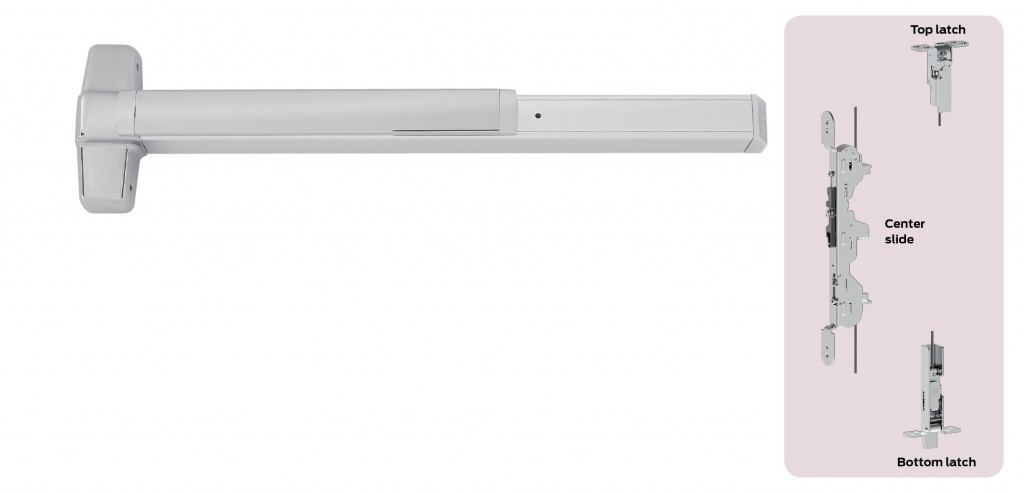
- Multi-Point – A multi-point device combines vertical rods and a rim device, for 3-point latching. These may be used for security purposes, or to meet windstorm requirements.
Additional Options
Trims and Controls – The outside trim or control is used to retract the panic hardware latch(es) from the exterior. The exit-only function has no exterior trim. Nightlatch function is typically used where panic hardware is “dogged” to unlock the door, and may have a cylinder only, a cylinder and a pull handle, or a cylinder with a fixed lever handle. In some cases, a thumbturn may be used in addition to the cylinder, to provide additional leverage to retract the latches. Lever trim is available in passage, storeroom, or classroom functions, as well as electrified functions. Knobs and thumbpiece trims are also available, although they are less commonly used because of current accessibility requirements.
Finishes – Panic hardware is available in a variety of finishes, including architectural plated finishes, stainless steel (when the base material is stainless steel), and powder coat finishes – both standard and custom colors.
Dogging – The act of dogging a panic device holds the latch or latches retracted to allow the door to operate as a push-pull function. This saves wear and tear on the hardware, and makes it easier for building occupants to use. Dogging may be done via hex-key or key cylinder, and must be specified with the preferred option.
Electrified Functions – Panic hardware can be supplied with electric latch retraction, electrified lever trim, delayed egress, controlled egress, alarms, switches, or other electrified options to meet the access control and monitoring needs of the facility.
Beyond the Basics
Much of the confusion surrounding panic hardware involves the addition of electrified functions, so it’s important to understand the codes pertaining to their use. Electric latch retraction, delayed egress, and controlled egress seem to generate the most questions among specifiers, so we’ll take a closer look at each of these functions.
Electric Latch Retraction
Let’s begin with electric latch retraction, which may be called EL, QEL, ELR, or electric dogging. A common question is whether it is acceptable to use electric latch retraction on fire exit hardware that is installed on fire doors. The short answer is yes, but there’s a much longer answer that should be understood as well.
One of the cardinal rules of fire doors is that they need to be “self-latching.” During a fire, a fire door must be positively latched in order to withstand the pressures created by the fire, and compartmentalize the building to deter the spread of smoke, flames, and gases. Generally this means that every fire door must be equipped with an active latchbolt, so that when the door comes to a close, it will latch. The latchbolt of a lockset or fire exit hardware would provide this positive latch. A deadbolt, roller latch, magnetic catch, or electromagnetic lock would not. A fail safe electric strike would not provide a positive-latch condition upon loss of power, so only fail secure electric strikes may be used on fire doors.
In some cases, the positive latch required for a fire door will interfere with the desired function of the door. For example, a push/pull function is preferred for a pair of doors leading to an operating room, but these doors are often fire-rated. NFPA 80 – Standard for Fire Doors and Other Opening Protectives, permits latching arrangements which do not provide positive latching in the normal mode, as long as the door automatically becomes positively latched during a fire emergency by an automatic fire detector.
Mechanical dogging can not be provided on fire exit hardware, but electric latch retraction fire exit hardware can be used to provide a push/pull function if it is wired so that the latch(es) will automatically project during a fire alarm. Panic hardware with electric latch retraction operates like normal panic hardware for egress – pushing the touchpad will allow free egress at all times. The EL feature retracts the latch using electricity, and when power is removed, the latch automatically projects and the door becomes latched.
An electric strike on a fire door should operate in the same manner – providing positive latching upon fire alarm. If the access control system allows an electric strike to remain unlocked for maintained periods, it’s possible that the strike keeper could be free during a fire emergency and allow the door to open. Both of these applications require a fire alarm contact within the system to cut power to the hardware upon fire alarm and ensure positive latching.
Delayed Egress
The use of delayed egress hardware prevents a door from being opened from the egress side, usually for a period of 15 seconds although an AHJ may approve a delay of up to 30 seconds. This type of device is often used to prevent theft or elopement, while maintaining life safety.
It is commonly comprised of panic hardware incorporating delayed egress features, or an electromagnetic lock and power supply, one of which would contain delayed egress circuitry. When the delayed egress lock is actuated, the door remains locked on the egress side for 15 seconds, and then releases to allow egress.
The International Building Code (IBC) and NFPA 101 – The Life Safety Code contain similar requirements for delayed egress locks, but there are some slight differences – particularly with regard to the occupancy types where delayed egress locks are allowed.
In buildings protected throughout by an automatic sprinkler system or automatic fire detection system, approved, listed, delayed egress locks are allowed in the following occupancy types:
- IBC: Delayed egress locks are allowed in any occupancy except Group A (Assembly), E (Educational), and H (High Hazard), but only one delayed egress lock is allowed per egress path. Prior to the 2015 edition of the IBC, one delay was allowed before entering an exit, rather than one delay per egress path. The 2015 edition of the IBC allows two delays per egress path in Group I-2 or I-3 occupancies with a combined delay of 30 seconds, maximum.
- NFPA 101: Delayed egress locks are allowed in buildings containing low- or ordinary-hazard contents, with the following limitations:
- Assembly Occupancies – Only doors other than main entrance/exit doors may be equipped with delayed egress locks. Exception: In airport loading walkways, doors in the egress path from the aircraft into the airport terminal are not permitted to have delayed egress locks.
- Educational / Day Care, Health Care, Ambulatory Health Care, Lodging and Rooming Houses, Hotels and Dormitories, Apartment Buildings, Mercantile, Business, Industrial, Storage – There are no restrictions in the 2015 edition of NFPA 101 for these occupancies. Previous editions limit delayed egress devices to one delay per escape path for some occupancy types. Prior to the 2003 edition of NFPA 101, delayed egress locks in Ambulatory Health Care occupancies were limited to exterior doors.
The code requires that a 15-pound force applied to the egress side door hardware shall initiate an irreversible process that allows egress in not more than 15 seconds unless a 30-second delay is approved by the AHJ. While NFPA 101 (all recent editions) and the 2015 edition of the IBC allow not more than 3 seconds of applied force to begin the process, previous editions of the IBC included a limit of 1 second to initiate the process. Initiation of the irreversible process must activate an audible alarm in the vicinity of the door. Doors must allow immediate egress (no delay) upon actuation of the automatic sprinkler system or automatic fire detection system. The IBC also requires the capability of release from the fire command center and other approved locations. NFPA 101 specifies that doors allow immediate egress (no delay) upon actuation of the sprinkler system, not more than one heat detector, or not more than two smoke detectors. Doors must also allow immediate egress (no delay) upon loss of power controlling the delayed egress lock.
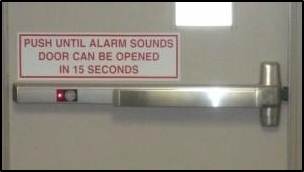 Signage is required to be mounted on the door, adjacent to the release device (the IBC specifies above and within 12″ of the door exit hardware), stating: “PUSH [PULL] UNTIL ALARM SOUNDS. DOOR CAN BE OPENED IN 15 [30] SECONDS.” NFPA 101 further specifies a visible, durable sign with letters 1″ high minimum with 1/8″ minimum stroke width on contrasting background. The 2015 IBC has added a requirement for the signage to comply with the visual character requirements of ICC A117.1. The 2015 IBC also includes an exception for Group I occupancies. Where the care recipients require restraint or containment, installation of a sign is not required.
Signage is required to be mounted on the door, adjacent to the release device (the IBC specifies above and within 12″ of the door exit hardware), stating: “PUSH [PULL] UNTIL ALARM SOUNDS. DOOR CAN BE OPENED IN 15 [30] SECONDS.” NFPA 101 further specifies a visible, durable sign with letters 1″ high minimum with 1/8″ minimum stroke width on contrasting background. The 2015 IBC has added a requirement for the signage to comply with the visual character requirements of ICC A117.1. The 2015 IBC also includes an exception for Group I occupancies. Where the care recipients require restraint or containment, installation of a sign is not required.
Lastly, emergency lighting is required on the egress side of the door and delayed egress devices must be rearmed manually.
Controlled Egress
Controlled egress (called “special egress” in the 2012 IBC) is often confused with delayed egress as the two share many of the same functions. However, there are some key differences between the two products as well as the codes regulating their use.
Controlled egress is typically used in an I-2 occupancy, which the IBC describes as a health care facility with 24-hour medical supervision for patients, with some or all of the occupants incapable of self-preservation and requiring assistance to reach safety in an emergency. Typically, hospitals, detox-facilities, nursing homes, and mental hospitals are considered I-2 occupancies.
These types of facilities often struggle with the balance between providing egress and protection from a fire, while also keeping their patients safe. “Elopement” is a term used to describe a nursing home or hospital patient leaving the unit or building on their own, which places them at risk of harm. Child and infant abduction is another concern when addressing the security of these facilities.
While psychiatric facilities have long been allowed some exceptions to the code requirements for free egress, many healthcare facilities have attempted to use a combination of code-compliant solutions, typically alarms and delayed egress locks, to prevent elopement and abduction. An alarm requires instantaneous response by staff, and a delayed egress lock only provides a 15-second egress delay (30 seconds with approval from the Authority Having Jurisdiction (AHJ)) to allow staff to investigate and respond. False alarms can exacerbate the problem. For many hospitals and nursing homes these products made it difficult to keep patients safe, which prompted some to use a waiver or variance process to request permission to secure certain egress doors. Without a consistent set of code requirements addressing these applications, it was up to the facility and AHJ to agree on an acceptable solution.
Revised language was added to the 2009 edition of the IBC to help address this issue, but the change also added to the confusion. Section 1008.1.9.6, “Special Locking Arrangements in Group I-2” describes the requirements for locking I-2 occupancies when the clinical needs of the patients require such locking. According to the IBC Commentary, these patients may include those with dementia / Alzheimer’s disease. Along with other requirements for the facility, this section describes locks that:
- unlock upon actuation of the sprinkler system / fire detection system, and
- unlock upon loss of power to the lock, and
- are capable of being unlocked remotely, and
- must be able to be unlocked by clinical staff at all times.
To meet these requirements, a fail-safe electrified lock would be used, which will unlock when power is removed. But the 2009 IBC section includes the term “delayed egress lock”, even though the requirements are not describing the product known by that name. There is no requirement in this section for a 15-second delay initiating unlocking, special signage, or a local alarm. By using a term that is an established type of electronic security product, the code may be interpreted to mean that a delayed egress lock is required, but the requirements listed in the code clearly describe a fail-safe electrified lock, not a delayed egress lock.
A change was approved and included in the 2012 edition of the IBC which revises the language for this section. Instead of “delayed egress lock”, the term “special egress lock” is used, which eliminates some of the confusion by avoiding the use of defined product name. Because this is more of a clarification rather than an actual change, it can be used to help explain the intent of this section even if the 2012 edition has not yet been adopted in a project’s jurisdiction. The 2015 edition of the IBC has settled on the term “controlled egress” to describe this application.
In theory, either fail-safe electromechanical locks or electromagnetic locks, or controlled egress panic hardware would meet the intent of this section of the IBC, as long as all of the stated criteria are met and the clinical needs of the patients require such measures. Because the codes do not specifically state which types of patient areas this applies to, that would need to be determined by the AHJ. If the door is fire-rated, it must have an active latch bolt to provide positive latching. For egress, it should take only one operation to unlatch the door after the lock has been released electronically.
Free egress is required by the IBC for these locations upon actuation of the fire alarm/sprinkler system, power failure, and remote release. The staff must be trained and ready to unlock the doors as needed, the building must be protected throughout with a sprinkler system / fire detection system, a building occupant must not pass through more than one door with a special egress lock before entering an exit, and emergency lighting must be provided at the door. Where patients require restraint or containment as part of the function of a psychiatric treatment area, some of the requirements for automated release of the doors do not apply.
Conclusion
While the codes surrounding the use of panic hardware can seem confusing and sometimes even contradictory, the role these products play in ensuring life safety and security within the built environment makes it vital that they be specified and installed correctly every time. Always verify which code and edition are to be used as well as the occupancy classification of the project, then apply the appropriate requirements to ensure that your specification and/or installation is code compliant.
You need to login or register to bookmark/favorite this content.

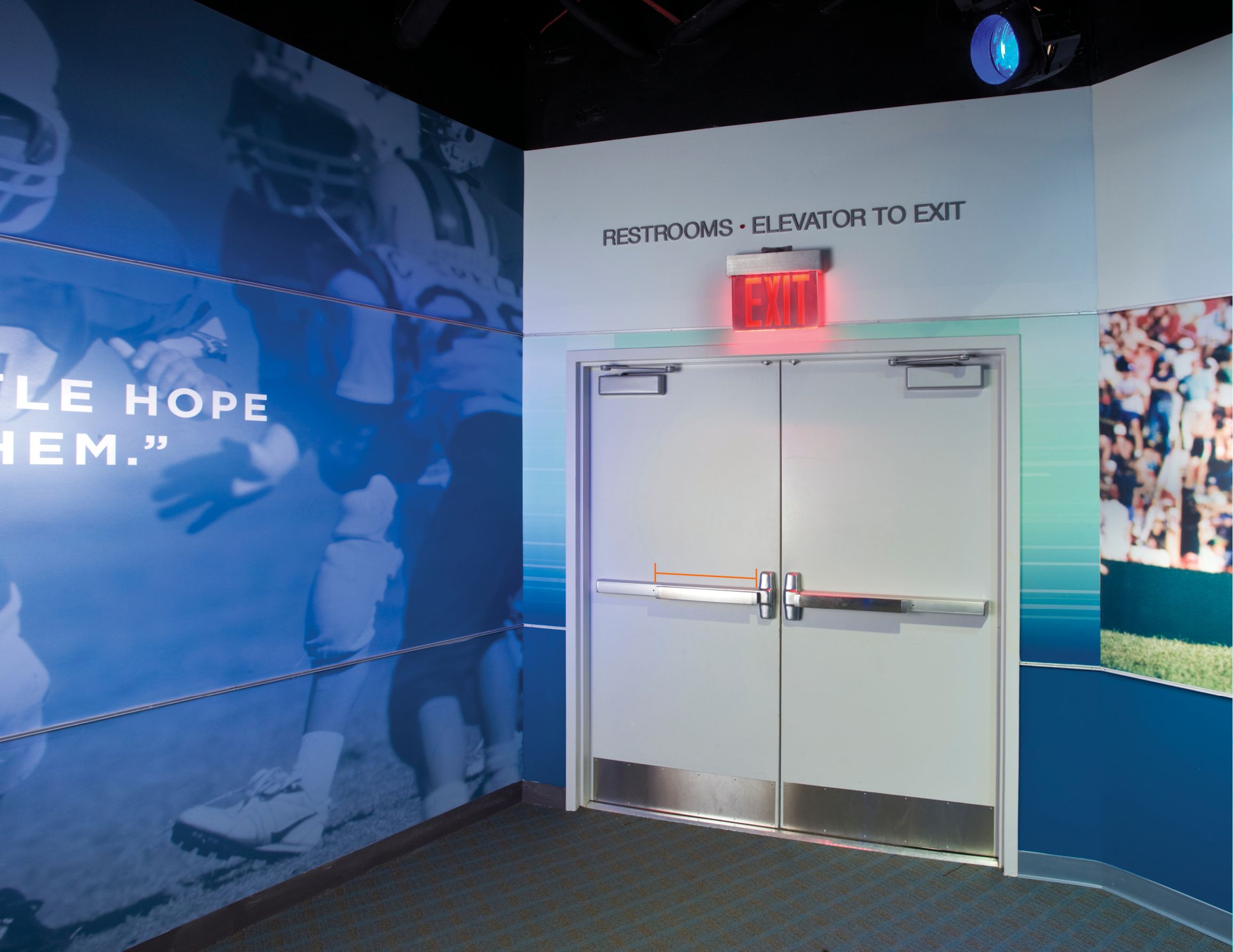
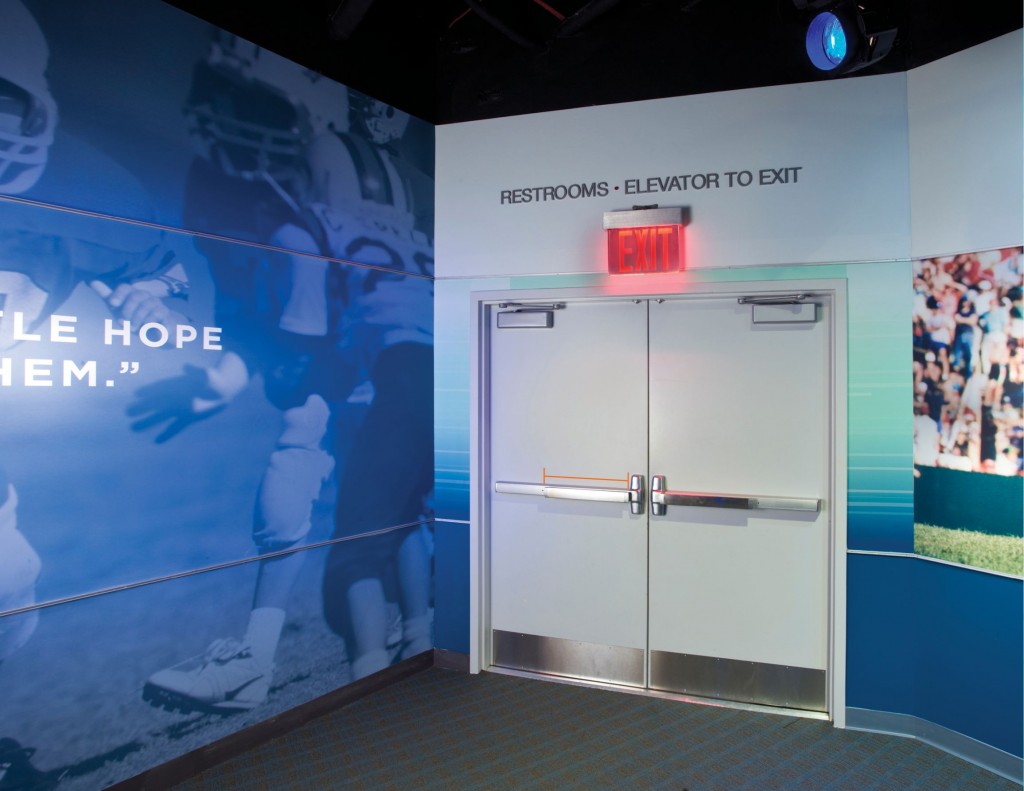


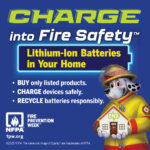
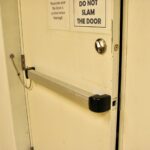
Lori,
Here in our Massachusetts, is it completely and thoroughly IBC now, or does Mass code still put its own spin on a few things?
Best regards,
Marcus
The Mass Code still has some modifications to the IBC.
Lori had to be non-product specific in this article, but one of the great stories in construction code history is how Carl Prinzler (the PRIN in Von Duprin) invented the panic device. It was a source of pride during my few years working for IR/Allegion that Von Duprin invented the product, and remained the leader in panic device technology over the years. I couldn’t find the pdf of the Iroquois Theater fire and invention story on the new website, but it’s a worthwhile and illustrative read if you can track it down.
https://legacy-uploads.ul.com/wp-content/uploads/sites/2/2019/03/RI_BLST_AR_047_UL303PanicHardware_0319_en.pdf
Just a note to add to why certain styles of panic hardware are chosen over other styles: When I worked in the Medical Center, we specified V-D 88 concealed rod crossbar devices in the basement corridors where there was a lot of cart and pallet truck traffic because they were nearly bulletproof and would withstand more abuse than any other style in that high traffic area. The Touchpad devices we tried in that area would literally explode on contact, and I was too afraid to use a recessed device for fear that it would take away from the door’s structural integrity.
Thanks Chuck!
Thank you Lori. This is the good stuff.
Lori,
Your article is fantastic!!! I’m working on a large hospital project and there have been countless discussions between us (the general contractor), the designer (both engineer and architect), and the end user(s) on the need for panic hardware on certain openings. I’m responsible for the energy center of the campus so your section on 2014 NEC (NFPA 70) requirements for “high hazard” areas was particularly helpful. Thanks again for the great article and for shedding some light on a very complex issue.
Cheers!
Ben
Thanks Ben! I appreciate the feedback!
– Lori
I would like to get a clarifucation about electrically controlled panic exit systems as per prEN 13637,Is it the same as delayed egress with ? What rules shall it obey ?and the mechanusm for electrically controlled exit systems prEN 13637 please
Hi Firyal –
I’m sorry, but I’m not familiar with the standards used outside of the US.
– Lori
This may sound like an odd question, but what do you do for panic hardware when an exterior assembly balcony on an upper floor egresses back into the building? The door swinging in and the hardware not being listed for exterior application (e.g., corrosion, electronics, etc.) are the first issues that come to mind. Creating a condition without latching won’t stand up to the weather either. Have you ever run across this before?
Hi Michael –
Sorry for the delay…I didn’t see your question until now. I have had several projects where there was a door similar to what you described. For exterior conditions I usually specify the Von Duprin 88 or 55 crossbar devices, with the device set in a bed of sealant on the door. I have used Von Duprin 99’s in some exterior applications, with weep holes drilled in the bottom of the bar and a lot of lubricant on the internal parts.
– Lori